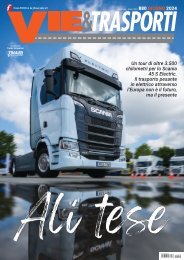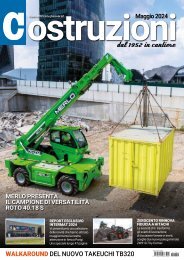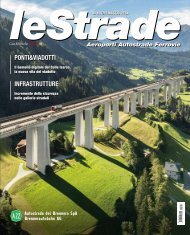LeStrade n. 1554 - gennaio/febbraio 2020
- Sicurezza: appello per tutelare le infrastrutture critiche - Gallerie: passato, presente e futuro della Napoli sotterranea - Materiali: l'economia circolare nelle pavimentazioni
- Sicurezza: appello per tutelare le infrastrutture critiche
- Gallerie: passato, presente e futuro della Napoli sotterranea
- Materiali: l'economia circolare nelle pavimentazioni
You also want an ePaper? Increase the reach of your titles
YUMPU automatically turns print PDFs into web optimized ePapers that Google loves.
112<br />
4<br />
trollo macchine SmoothRide che garantirà l’assenza, praticamente<br />
totale, di ogni tipo di asperità lungo l’intero tracciato.<br />
Non si sono limitati a questo. Il team ha anche dovuto<br />
modificare la pendenza di tutto il circuito, lungo 5.500 m,<br />
per ottimizzare il drenaggio dell’acqua. Anche se le analisi<br />
3D di SmoothRide non erano mai state utilizzate su una<br />
pista da corsa, Tarmac, NRP e Dromo hanno riconosciuto<br />
il potenziale di questa tecnologia di precisione, che aveva<br />
già dato ottimi risultati in progetti realizzati su autostrade<br />
e piste di aeroporti. Era la prima volta che questa tecnologia<br />
veniva utilizzata nel Regno Unito. A proposito della nabe<br />
dovuto servire delle tecnologie di pavimentazione stradale<br />
più avanzate.<br />
4. La speciale corsa delle<br />
macchine operatrici<br />
English Version<br />
Scaldare i motori<br />
Il complesso progetto di asfaltatura è stato affidato a un<br />
team di esperti guidato da Tarmac, l’appaltatore principale,<br />
e dalla Dromo, azienda italiana specializzata nel design<br />
di circuiti. NRP, azienda leader nel settore della pavimentazione<br />
stradale acquisita da Tarmac, ha assunto la guida del<br />
progetto di fresatura, in collaborazione con il gruppo Topcon<br />
Positioning che ha fornito la sua avanzata tecnologia di conto<br />
eradicate any risk of bumps, but also so we could shape<br />
a new camber that would make sure all water runs off to<br />
avoid aquaplaning”.<br />
Gli Innovatori<br />
A Smooth Surface<br />
The project team first carried out a scan of the existing surface<br />
to precisely identify where any bumps were and where<br />
standing water might be likely. This scan data was then converted<br />
into a 3D digital terrain model (DTM) using Topcon’s<br />
Magnet Collage software, with the model being used to inform<br />
the new design. It was decided that milling machines<br />
would be used to shape the new track as they can make the<br />
surface extremely level, meaning the subsequent paving<br />
can be done in a constant layer thickness. This has advantages<br />
not just for the placing, rolling and compacting of the<br />
material, but also for the actual lifespan of the surface. Sjoerd<br />
Stoové added: “The difference between the existing surface<br />
and the new design resulted in an average milling depth<br />
of 70mm over the whole racetrack. However, the problem<br />
with averages is that in some places you need to mill more,<br />
where in others you need to mill far less, or even not at all.<br />
Traditionally, a surveyor would need to spend days on the<br />
track to stake out all the milling depths and the crew on the<br />
machine then need to manually make sure those numbers<br />
are adhered to”. This was all avoided with Topcon’s RD-MC<br />
Machine Control system. Firstly, Magnet Office and 3D Office<br />
were used to create the files needed for machine control<br />
from the design. The system was then able to use GNSS positioning<br />
to accurately calculate the difference between the<br />
existing surface and the new design at any given position,<br />
and therefore determine the desired milling depths. Sensors<br />
on the machines - in this case, two Wirtgen W210Fi machines<br />
4. The special “race”<br />
of the paving machines<br />
1-2/<strong>2020</strong> leStrade


















